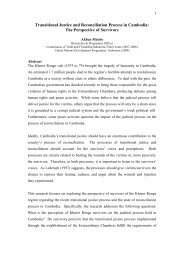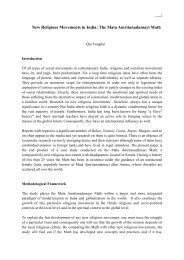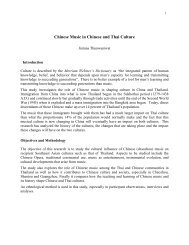Private Sector Participation in Affirmative Action in Malaysia: - Asian ...
Private Sector Participation in Affirmative Action in Malaysia: - Asian ...
Private Sector Participation in Affirmative Action in Malaysia: - Asian ...
Create successful ePaper yourself
Turn your PDF publications into a flip-book with our unique Google optimized e-Paper software.
Ch<strong>in</strong>ese share ownership, the Malay ownership expanded at a much faster rate dur<strong>in</strong>g<br />
1970-1985 (Jesudason, 1991). Of course, it was another th<strong>in</strong>g that a greater portion of this<br />
<strong>in</strong>crease <strong>in</strong> the Malay share of corporate wealth was due to acquisitions made by state-led<br />
banks, trust agencies, and public enterprises than private sector restructur<strong>in</strong>g.<br />
In terms of employment restructur<strong>in</strong>g, the figures more or less come closer to the NEP<br />
targets. By 1990, the share of the Malays tak<strong>in</strong>g up agricultural jobs plummeted from<br />
66.2 per cent to 19 per cent, while newly hired Malays <strong>in</strong> the secondary and tertiary<br />
sectors grew from a low 12.1 per cent to 30.5 per cent and 21.7 per cent to 40.5 per cent,<br />
respectively. These figures are a proof that employment restructur<strong>in</strong>g policy was largely<br />
successful <strong>in</strong> mov<strong>in</strong>g Bumiputeras from the traditional agriculture sector to the more<br />
modern sectors (Onozawa, 1991). The Malays made rapid <strong>in</strong>road <strong>in</strong>to commercial and<br />
manufactur<strong>in</strong>g sector largely because of the NEP led affirmative action. For <strong>in</strong>stance,<br />
between 1980-90, 340,000 out of 5,35,000 manufactur<strong>in</strong>g generated jobs (64 per cent)<br />
were occupied by the Malay labour force. Therefore, because of NEP employment<br />
restructur<strong>in</strong>g requirements, the entire employment structure <strong>in</strong> manufactur<strong>in</strong>g changed <strong>in</strong><br />
just two decades.<br />
Besides, the Bumiputera proportion of the eight prized professions rose from 4.9 per cent<br />
<strong>in</strong> 1970 to 29.0 per cent <strong>in</strong> 1990 and 33.1 per cent <strong>in</strong> 1995 to 38.8 per cent <strong>in</strong> 2005<br />
(Government <strong>Malaysia</strong>, 1976, 2005). In terms of comb<strong>in</strong>ed public and private sector<br />
employment <strong>in</strong> professional services such as account<strong>in</strong>g, architecture, dental,<br />
eng<strong>in</strong>eer<strong>in</strong>g, law, and so on, between 1990 and 1999, the ethnic percentage changed from<br />
20.7% to 28.9% for Malays, from 59.3% to 53.9% for the Ch<strong>in</strong>ese, and from 17.5% to<br />
15.5% for Indians (EPU, 2001).<br />
However, there are still many black spots <strong>in</strong> terms of Bumiputera’s ascendancy <strong>in</strong> the<br />
professional occupations. For <strong>in</strong>stance, despite all efforts and concessions, the<br />
Bumiputeras were significantly underrepresented (less than 45 per cent) only at the<br />
“adm<strong>in</strong>istrative and managerial’ levels (at 37.0 per cent) and sales related occupations (at<br />
and pro-Bumiputera groups.<br />
24







